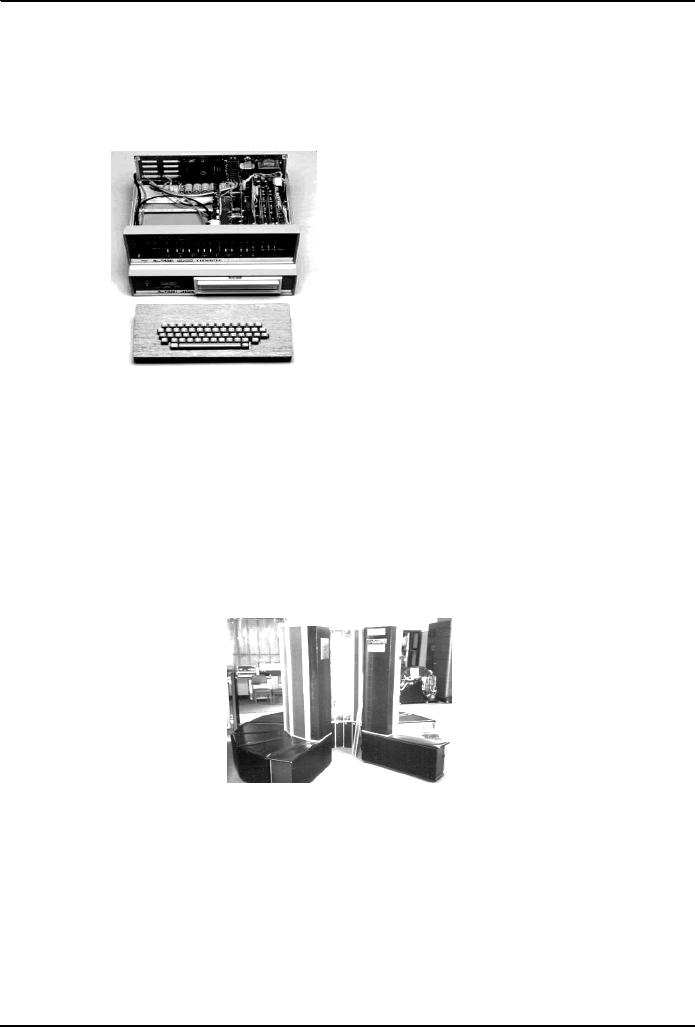 |
EVOLUTION OF COMPUTING |
| << INTRODUCTION |
| World Wide Web, Web’s structure, genesis, its evolution >> |

Introduction
to Computing CS101
VU
LESSON
2
EVOLUTION
OF COMPUTING
Today's
Goal
To
learn about the evolution of
computing
To recount the
important and key
events
To
identify some of the milestones in computer
development
Babbage's
Analytical Engine -
1833
Mechanical,
digital, general-purpose
Was
crank-driven
Could
store instructions
Could
perform mathematical calculations
Had
the ability to print
Could
punched cards as permanent memory
Invented
by Joseph-Marie Jacquard
2.1
Turing
Machine 1936
Introduced
by Alan Turing in 1936,
Turing machines are one of
the key abstractions used in
modern
computability
theory, the study of what
computers can and cannot do. A
Turing machine is a
particularly
simple kind of computer, one whose
operations are limited to reading
and writing symbols
on a tape, or
moving along the tape to the
left or right. The tape is
marked off into squares,
each of
which
can be filled with at most
one symbol. At any given
point in its operation, the
Turing machine
can
only read or write on one of
these squares, the square
located directly below its
"read/write" head.
2.2
The
"Turing test"
A
test proposed to determine if a computer
has the ability to think. In
1950, Alan Turing (Turing,
1950)
proposed a
method for determining if
machines can think. This
method is known as The Turing
Test.
The
test is conducted with two
people and a machine. One person
plays the role of an interrogator and
is
in a
separate room from the
machine and the other person. The
interrogator only knows the
person and
machine as A
and B. The interrogator does
not know which the person is
and which the machine is.
Using
a teletype, the interrogator, can
ask A and B any question
he/she wishes. The aim of
the
interrogator
is to determine which
the person is and which
the machine is.
The
aim of the machine is to fool the
interrogator into thinking
that it is a person. If the
machine
succeeds
then we can conclude that
machines can think.
Terminal
Human
providing
answers
Terminal
Interrogator
asking
questions
Computer
on its
own
Computer
providing
answers
2.3
Tube
1904:
Vacuum
A vacuum
tube is just that: a glass
tube surrounding a vacuum (an area
from which all gases
has been
removed).
What makes it interesting is
that when electrical
contacts are put on the
ends, you can get a
current
to flow though that
vacuum.
5

Introduction
to Computing CS101
VU
A
British scientist named John A. Fleming
made a vacuum tube known
today as a diode. Then the
diode
was
known as a "valve,"
2.4
ABC
1939
The
Atanasoff-Berry Computer was the
world's first electronic
digital computer. It was built by
John
Vincent
Atanasoff and Clifford Berry
at Iowa State University
during 1937-42. It incorporated
several
major
innovations in computing including the
use of binary arithmetic,
regenerative memory,
parallel
processing,
and separation of memory and computing
functions.
2.5
Harvard
Mark 1 1943:
Howard
Aiken and Grace Hopper
designed the MARK series of computers at
Harvard University.
The
MARK
series of computers began
with the Mark I in 1944.
Imagine a giant roomful of
noisy, clicking
metal
parts, 55 feet long and 8
feet high. The 5-ton
device contained almost 760,000
separate pieces.
Used by the US
Navy for gunnery and
ballistic calculations, the Mark I
was in operation until
1959.
The
computer, controlled by pre-punched paper tape, could
carry out addition,
subtraction,
multiplication,
division and reference to previous
results. It had special subroutines for
logarithms and
trigonometric
functions and used 23 decimal place
numbers. Data was stored and
counted mechanically
using
3000 decimal storage wheels,
1400 rotary dial switches,
and 500 miles of wire.
Its
electromagnetic
relays classified the machine as a relay computer. All
output was displayed on
an
electric
typewriter. By today's standards, the
Mark I was slow, requiring
3-5 seconds for a
multiplication
operation
2.6
ENIAC
1946:
ENIAC
I (Electrical
Numerical
Integrator
And Calculator).
The U.S. military sponsored
their research;
they
needed a calculating device
for writing artillery-firing
tables (the settings used
for different
weapons
under varied conditions for
target accuracy).
John
Mauchly was the chief consultant and J
Presper Eckert was the chief
engineer. Eckert was
a
graduate student
studying at the Moore School
when he met John Mauchly in
1943. It took the
team
about
one year to design the ENIAC and 18
months and 500,000 tax
dollars to build it.
The
ENIAC contained 17,468 vacuum
tubes, along with 70,000
resistors and 10,000 capacitors.
2.7
Transistor
1947
The
first transistor was invented at
Bell Laboratories on December
16, 1947 by William
Shockley. This
was
perhaps the most important electronics
event of the 20th century, as it
later made possible the
integrated
circuit and microprocessor that
are the basis of modern electronics.
Prior to the transistor the
only
alternative to its current
regulation and switching functions
(TRANSfer resISTOR) was
the
vacuum
tubes, which could only be
miniaturized to a certain extent, and
wasted a lot of energy in
the
form
of heat.
Compared to vacuum
tubes, it offered:
smaller
size
better
reliability
lower
power consumption
lower
cost
2.8
Floppy
Disk 1950
Invented
at the Imperial University in Tokyo by
Yoshiro Nakamats
6

Introduction
to Computing CS101
VU
2.9
UNIVAC 1
1951
UNIVAC-1.
The first commercially
successful electronic computer, UNIVAC I,
was also the first
general
purpose computer - designed to handle
both numeric and textual
information. It was designed by
J.
Presper Eckert and John Mauchly.
The implementation of this machine marked
the real beginning of
the computer
era. Remington Rand delivered the
first UNIVAC machine to the U.S. Bureau
of Census
in
1951. This machine used magnetic
tape for input.
First
successful commercial computer design was
derived from the ENIAC (same
developers)
first
client = U.S. Bureau of the
Census
$1
million
48
systems built
2.10
Compiler
1952
Grace
Murray Hopper an employee of
Remington-Rand worked on the NUIVAC.
She took up the
concept
of reusable software in her 1952 paper
entitled "The Education of a
Computer" and developed
the
first software that could
translate symbols of higher computer languages
into machine language.
(Compiler)
2.11
ARPANET
1969
The
Advanced Research Projects
Agency was formed with an
emphasis towards research, and thus
was
not
oriented only to a military
product. The formation of
this agency was part of the
U.S. reaction to the
then
Soviet Union's launch of
Sputnik in 1957. (ARPA
draft, III-6). ARPA was
assigned to research
how
to utilize their investment in
computers via Command and
Control Research (CCR). Dr.
J.C.R.
Licklider
was chosen to head this
effort
Developed
for the US DoD Advanced
Research Projects Agency
60,000 computers connected
for
communication
among research organizations and
universities
2.12
Intel
4004 1971
The
4004 was the world's first
universal microprocessor. In the late
1960s, many scientists had
discussed
the possibility of a computer on a chip,
but nearly everyone felt
that integrated
circuit
technology
was not yet ready to support
such a chip. Intel's Ted
Hoff felt differently; he
was the first
person
to recognize that the new silicon-gated
MOS technology might make a
single-chip CPU
(central
processing
unit) possible.
Hoff
and the Intel team developed
such architecture with just
over 2,300 transistors in an
area of only 3
by 4
millimeters. With its 4-bit
CPU, command register, decoder, decoding
control, control
monitoring
of machine
commands and interim register, the 4004
was one heck of a little invention.
Today's 64-bit
microprocessors
are still based on similar
designs, and the microprocessor is
still the most
complex
mass-produced
product ever with more than
5.5 million transistors
performing hundreds of millions of
calculations
each second - numbers that
are sure to be outdated
fast.
2.13
Altair
8800 1975
By
1975 the market for the personal computer
was demanding a product that
did not require an
electrical
engineering background and thus the
first mass produced and marketed personal
computer
7

Introduction
to Computing CS101
VU
(available
both as a kit or assembled)
was welcomed with open arms.
Developers Edward Roberts,
William
Yates and Jim Bybee spent
1973-1974 to develop the MITS (Micro
Instruments Telemetry
Systems
) Altair 8800. The price
was $375, contained 256
bytes of memory (not 256k),but had
no
keyboard,
no display, and no auxiliary storage
device. Later, Bill Gates
and Paul Allen wrote their
first
product
for the Altair -- a BASIC
compiler (named after a
planet on a Star
Trek episode).
2.14
Cray
1 976
It
looked like no other computer
before, or for that matter,
since. The Cray 1 was the
world's first
"supercomputer,"
a machine that leapfrogged existing
technology when it was
introduced in 1971.
And
back then, you couldn't just
order up fast processors from
Intel. "There weren't
any
microprocessors,"
says Gwen Bell of The
Computer Museum History Center. "These
individual
integrated
circuits that are on the
board performed different
functions."
Each
Cray 1, like this one at
The Computer Museum History
Center, took months to build.
The
hundreds of
boards and thousands of wires had to
fit just right. "It was
really a hand-crafted
machine,"
adds
Bell. "You think of all
these wires as a kind of
mess, but each one
has a precise
length."
2.15
IBM PC
1981
On
August 12, 1981, IBM
released their new computer, re-named the
IBM PC. The "PC" stood
for
"personal
computer" making IBM responsible for
popularizing the term
"PC".
The
first IBM PC ran on a 4.77 MHz Intel
8088 microprocessor. The PC came
equipped with 16
kilobytes
of memory, expandable to 256k.
The PC came with one or two
160k Floppy Disks Drives
and
an
optional color monitor. The
price tag started at $1,565,
which would be nearly $4,000
today.
8

Introduction
to Computing CS101
VU
2.16
Apple
Macintosh 1984
Apple
introduced the Macintosh to the nation on
January 22, 1984. The
original Macintosh had
128
kilobytes
of RAM, although this first
model was simply called
"Macintosh" until the 512K
model came
out
in September 1984. The
Macintosh retailed for
$2495. It wasn't until the
Macintosh that the general
population
really became aware of the
mouse-driven graphical user
interface.
2.17
World
Wide Web -1989
"CERN
is a meeting place for physicists from
all over the world, who
collaborate on complex physics,
engineering
and information handling projects. Thus, the
need for the WWW system
arose "from the
geographical
dispersion of large collaborations, and the fast
turnover of fellows, students, and
visiting
scientists,"
who had to get "up to speed on projects
and leave a lasting contribution
before leaving."
CERN
possessed both the financial and
computing resources necessary to
start the project. In the
original
proposal, Berners-Lee outlined two
phases of the project:
First,
CERN would "make use of
existing software and hardware as well as
implementing simple
browsers
for the user's workstations,
based on an analysis of the requirements for
information access
needs
by experiments."
Second,
they would "extend the
application area by also
allowing the users to add new
material."
Berners-Lee
expected each phase to take three months
"with the full manpower complement": he
was
asking
for four software engineers and a
programmer. The proposal talked about "a
simple scheme to
incorporate
several different servers of machine-stored
information already available at
CERN."
Set
off in 1989, the WWW quickly
gained great popularity among Internet
users. For instance, at
11:22
am of
April 12, 1995, the WWW
server at the SEAS of the University of
Pennsylvania "responded to
128
requests in one minute. Between
10:00 and 11:00
2.18
Quantum
Computing with
Molecules
by
Neil Gershenfeld and Isaac
L. Chuang
Factoring
a number with 400 digits--a
numerical feat needed to
break some security
codes--would take
even the
fastest supercomputer in existence billions of
years. But a newly conceived
type of computer,
one
that exploits quantum-mechanical
interactions, might complete the task in
a year or so, thereby
defeating
many of the most sophisticated encryption
schemes in use. Sensitive
data are safe for the
time
being,
because no one has been able
to build a practical quantum computer.
But researchers have
now
demonstrated
the feasibility of this approach. Such a
computer would look nothing
like the machine that
sits
on your desk; surprisingly, it might
resemble the cup of coffee at its
side.
Several
research groups believe quantum
computers based on the molecules in a
liquid might one day
overcome
many of the limits facing
conventional computers. Roadblocks to
improving conventional
computers
will ultimately arise from
the fundamental physical bounds to
miniaturization (for
example,
because
transistors and electrical wiring cannot
be made slimmer than the
width of an atom). Or
they
may
come about for practical
reasons--most likely because the
facilities for fabricating
still more
powerful
microchips will become
prohibitively expensive. Yet
the magic of quantum mechanics
might
solve
both these problems.
9
Table of Contents:
- INTRODUCTION
- EVOLUTION OF COMPUTING
- World Wide Web, Web’s structure, genesis, its evolution
- Types of Computers, Components, Parts of Computers
- List of Parts of Computers
- Develop your Personal Web Page: HTML
- Microprocessor, Bus interface unit, Data & instruction cache memory, ALU
- Number systems, binary numbers, NOT, AND, OR and XOR logic operations
- structure of HTML tags, types of lists in web development
- COMPUTER SOFTWARE: Operating Systems, Device Drivers, Trialware
- Operating System: functions, components, types of operating systems
- Forms on Web pages, Components of Forms, building interactive Forms
- APPLICATION SOFTWARE: Scientific, engineering, graphics, Business, Productivity, Entertainment, Educational Software
- WORD PROCESSING: Common functions of word processors, desktop publishing
- Interactivity to Forms, JavaScript, server-side scripts
- ALGORITHMS
- ALGORITHMS: Pseudo code, Flowcharts
- JavaScript and client-side scripting, objects in JavaScript
- Low, High-Level, interpreted, compiled, structured & object-oriented programming languages
- Software Design and Development Methodologies
- DATA TYPES & OPERATORS
- SPREADSHEETS
- FLOW CONTROL & LOOPS
- DESIGN HEURISTICS. Rule of thumb learned through trial & error
- WEB DESIGN FOR USABILITY
- ARRAYS
- COMPUTER NETWORKS: types of networks, networking topologies and protocols
- THE INTERNET
- Variables: Local and Global Variables
- Internet Services: FTP, Telnet, Web, eMail, Instant messaging, VoIP
- DEVELOPING PRESENTATIONS: Effective Multimedia Presentations
- Event Handlers
- GRAPHICS & ANIMATION
- INTELLIGENT SYSTEMS: techniques for designing Artificial Intelligent Systems
- Mathematical Functions in JavaScript
- DATA MANAGEMENT
- DATABASE SOFTWARE: Data Security, Data Integrity, Integrity, Accessibility, DBMS
- String Manipulations:
- CYBER CRIME
- Social Implications of Computing
- IMAGES & ANIMATION
- THE COMPUTING PROFESSION
- THE FUTURE OF COMPUTING
- PROGRAMMING METHODOLOGY
- REVIEW & WRAP-UP of Introduction to Computing